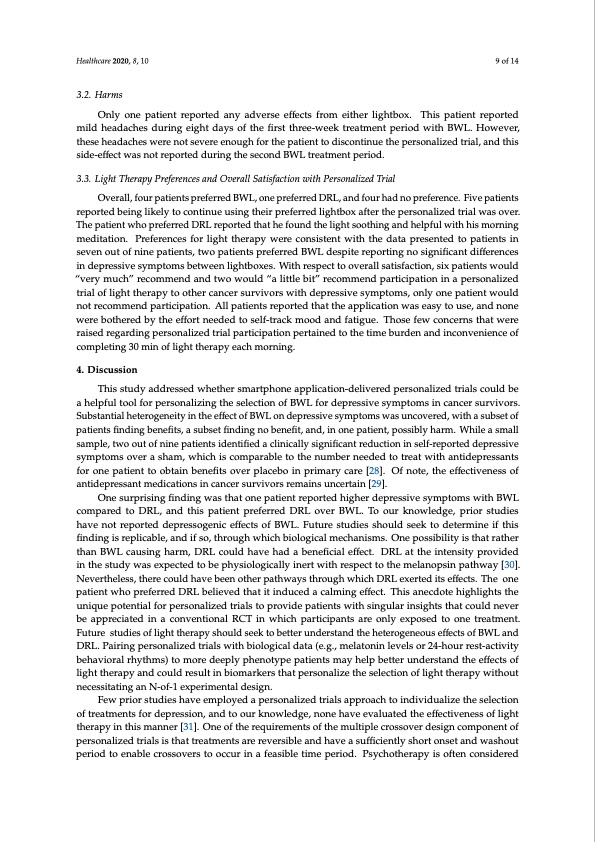
PDF Publication Title:
Text from PDF Page: 009
Healthcare 2020, 8, 10 9 of 14 3.2. Harms Only one patient reported any adverse effects from either lightbox. This patient reported mild headaches during eight days of the first three-week treatment period with BWL. However, these headaches were not severe enough for the patient to discontinue the personalized trial, and this side-effect was not reported during the second BWL treatment period. 3.3. Light Therapy Preferences and Overall Satisfaction with Personalized Trial Overall, four patients preferred BWL, one preferred DRL, and four had no preference. Five patients reported being likely to continue using their preferred lightbox after the personalized trial was over. The patient who preferred DRL reported that he found the light soothing and helpful with his morning meditation. Preferences for light therapy were consistent with the data presented to patients in seven out of nine patients, two patients preferred BWL despite reporting no significant differences in depressive symptoms between lightboxes. With respect to overall satisfaction, six patients would “very much” recommend and two would “a little bit” recommend participation in a personalized trial of light therapy to other cancer survivors with depressive symptoms, only one patient would not recommend participation. All patients reported that the application was easy to use, and none were bothered by the effort needed to self-track mood and fatigue. Those few concerns that were raised regarding personalized trial participation pertained to the time burden and inconvenience of completing 30 min of light therapy each morning. 4. Discussion This study addressed whether smartphone application-delivered personalized trials could be a helpful tool for personalizing the selection of BWL for depressive symptoms in cancer survivors. Substantial heterogeneity in the effect of BWL on depressive symptoms was uncovered, with a subset of patients finding benefits, a subset finding no benefit, and, in one patient, possibly harm. While a small sample, two out of nine patients identified a clinically significant reduction in self-reported depressive symptoms over a sham, which is comparable to the number needed to treat with antidepressants for one patient to obtain benefits over placebo in primary care [28]. Of note, the effectiveness of antidepressant medications in cancer survivors remains uncertain [29]. One surprising finding was that one patient reported higher depressive symptoms with BWL compared to DRL, and this patient preferred DRL over BWL. To our knowledge, prior studies have not reported depressogenic effects of BWL. Future studies should seek to determine if this finding is replicable, and if so, through which biological mechanisms. One possibility is that rather than BWL causing harm, DRL could have had a beneficial effect. DRL at the intensity provided in the study was expected to be physiologically inert with respect to the melanopsin pathway [30]. Nevertheless, there could have been other pathways through which DRL exerted its effects. The one patient who preferred DRL believed that it induced a calming effect. This anecdote highlights the unique potential for personalized trials to provide patients with singular insights that could never be appreciated in a conventional RCT in which participants are only exposed to one treatment. Future studies of light therapy should seek to better understand the heterogeneous effects of BWL and DRL. Pairing personalized trials with biological data (e.g., melatonin levels or 24-hour rest-activity behavioral rhythms) to more deeply phenotype patients may help better understand the effects of light therapy and could result in biomarkers that personalize the selection of light therapy without necessitating an N-of-1 experimental design. Few prior studies have employed a personalized trials approach to individualize the selection of treatments for depression, and to our knowledge, none have evaluated the effectiveness of light therapy in this manner [31]. One of the requirements of the multiple crossover design component of personalized trials is that treatments are reversible and have a sufficiently short onset and washout period to enable crossovers to occur in a feasible time period. Psychotherapy is often consideredPDF Image | Bright White Light Therapy for Depression in Cancer Survivors

PDF Search Title:
Bright White Light Therapy for Depression in Cancer SurvivorsOriginal File Name Searched:
healthcare-08-00010.pdfDIY PDF Search: Google It | Yahoo | Bing
Cruise Ship Reviews | Luxury Resort | Jet | Yacht | and Travel Tech More Info
Cruising Review Topics and Articles More Info
Software based on Filemaker for the travel industry More Info
The Burgenstock Resort: Reviews on CruisingReview website... More Info
Resort Reviews: World Class resorts... More Info
The Riffelalp Resort: Reviews on CruisingReview website... More Info
| CONTACT TEL: 608-238-6001 Email: greg@cruisingreview.com | RSS | AMP |